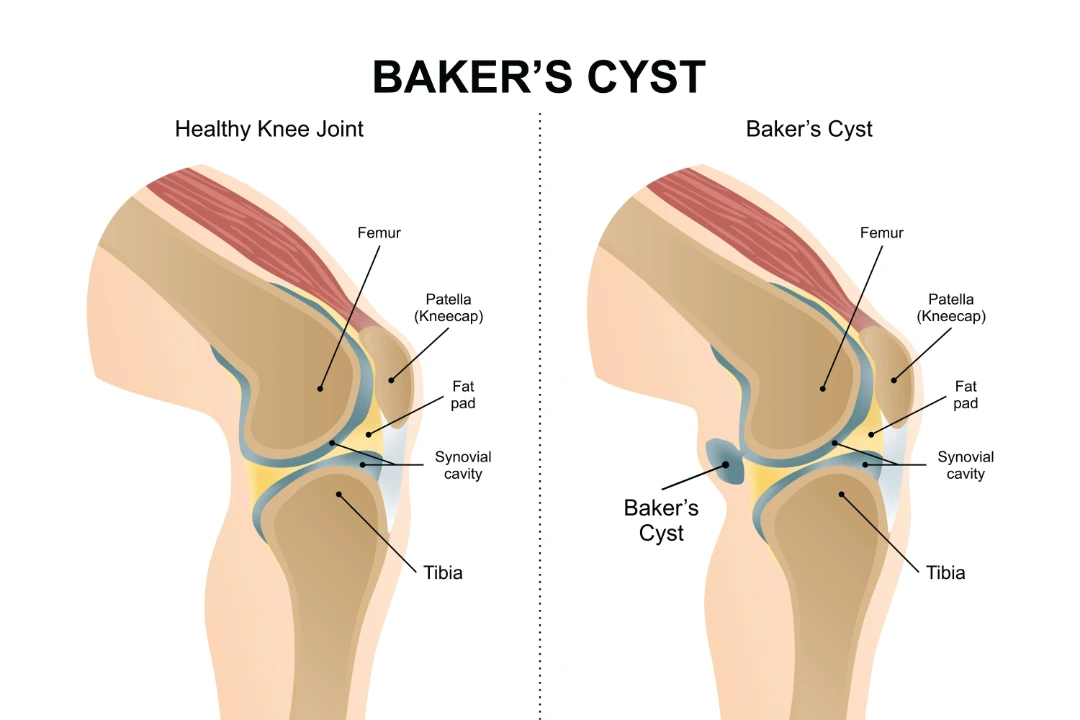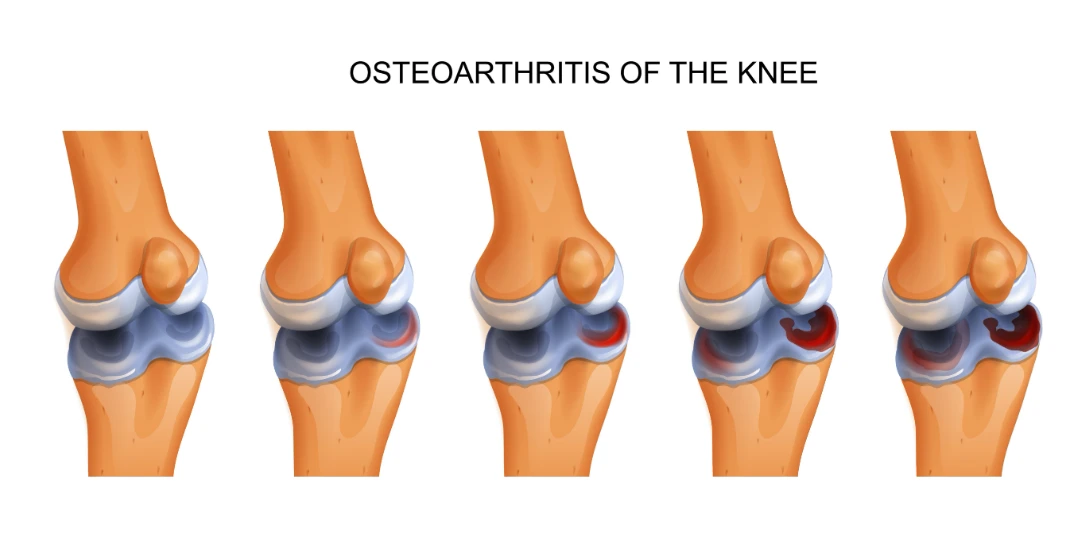Baker’s
(Popliteal) Cyst
- Home
- Conditions We Treat
- Foot & Ankle
- Baker’s (Popliteal) Cyst

What is Baker’s (Popliteal) Cyst?
A Baker’s cyst, also known as a popliteal cyst, is a fluid-filled swelling that develops at the back of the knee, within the popliteal fossa. This condition occurs when excess synovial fluid, which normally lubricates the knee joint, is forced into the popliteal bursa—a small sac located behind the knee joint. As fluid accumulates, the bursa becomes swollen, forming a noticeable lump.
This condition can lead to discomfort or tightness in the knee, particularly during activities like bending or straightening the leg. While the cyst itself is typically non-threatening, it may cause pain and restrict movement if it becomes large or ruptures. In some cases, a ruptured cyst can lead to fluid leakage into the calf, mimicking symptoms of a deep vein thrombosis (DVT), such as swelling or redness.
What causes Baker’s (Popliteal) Cyst?
A Baker’s (popliteal) cyst is typically caused by an overproduction of synovial fluid in the knee joint, which leads to its accumulation in the popliteal bursa, a small sac behind the knee. This excess fluid is usually a result of underlying joint conditions such as osteoarthritis, rheumatoid arthritis, or injuries like meniscus tears.
When the knee is affected by these issues, the body produces more synovial fluid to lubricate and protect the joint. However, the extra fluid can create pressure, pushing into the bursa and forming the cyst. The increased volume in the joint creates swelling in the popliteal fossa, leading to discomfort, restricted movement, and a visible bulge at the back of the knee.

What are the symptoms of Baker’s (Popliteal) Cyst?
The symptoms of a Baker’s cyst can vary depending on the size of the cyst and the severity of the underlying joint condition. Common symptoms include:
- Swelling behind the knee: this is the most noticeable symptom, with a visible lump or bulge forming at the back of the knee, often described as a soft mass.
- Knee pain or discomfort: the cyst can cause aching or pain, particularly when the knee is extended or flexed, which makes it difficult to perform activities that require bending the knee.
- Stiffness or tightness in the knee: some individuals experience a feeling of tightness or fullness in the back of the knee, which can limit the range of motion.
- Clicking or locking sensation: in some cases, the cyst can cause the knee to lock or click during movement.
- Swelling in the calf: if the cyst ruptures, fluid can leak into the calf, causing swelling and discomfort in the lower leg, which may resemble symptoms of a deep vein thrombosis (DVT).
- Reduced mobility: larger cysts can significantly restrict movement, making it difficult to walk, climb stairs, or perform physical activities.
These symptoms may worsen with physical activity and may fluctuate based on the size of the cyst and any accompanying knee joint conditions.

Who is at risk of Baker’s (Popliteal) Cyst in Singapore?
Individuals who suffer from chronic knee conditions are at higher risk of developing a Baker’s (popliteal) cyst. In Singapore, this is particularly common among those with:
- Osteoarthritis: as one of the most prevalent joint disorders, especially in older adults, osteoarthritis leads to the degeneration of cartilage in the knee, causing excess fluid production and increasing the likelihood of cyst formation.
- Rheumatoid arthritis: those with rheumatoid arthritis, an autoimmune disorder that inflames the knee joint lining, often experience increased synovial fluid production, which puts them at greater risk for Baker’s cysts.
- Knee injuries: individuals who have experienced injuries such as meniscus tears or ligament damage may develop cysts due to the knee’s response to injury, which often includes producing more synovial fluid to protect the joint.
- Athletes and physically active individuals: high-impact sports or activities that involve repetitive knee movements (e.g., running, football, or cycling) can stress the knee joint and lead to inflammation, raising the chances of developing a Baker’s cyst.
- People who have undergone knee surgery: previous surgeries, such as knee replacement or meniscus repair, can also increase the risk of Baker’s cyst as the joint may produce more synovial fluid during recovery.
In Singapore, where there is a rising trend of knee-related issues due to an ageing population and increasing sports participation, these risk factors are especially relevant. Those experiencing chronic knee pain or swelling should seek medical advice for early diagnosis and treatment of any underlying conditions.
How is Baker’s (Popliteal) Cyst diagnosed?
At Cove Orthopaedic, we take a comprehensive and patient-centred approach to diagnosing Baker’s (popliteal) cysts. We use the following methods to accurately identify Baker’s cysts and rule out other conditions:
- Physical examination: our specialists will check the back of your knee for visible swelling, tenderness, and restricted movement, which helps them determine if a cyst might be present.
- Ultrasound: our specialist may use this non-invasive imaging technique to confirm the presence of a fluid-filled cyst and distinguish it from other potential causes of swelling, such as a blood clot.
- MRI scan: in some cases, we may use MRI scan for a detailed view of the knee joint, particularly if there are other underlying issues like arthritis or meniscus damage. MRI provides a comprehensive image of the structures surrounding the cyst.
What are the treatment options for Baker’s (Popliteal) Cyst?
At Cove Orthopaedic, we offer a range of personalised treatment options for Baker’s (popliteal) cyst, tailored to your specific needs and the underlying cause of the cyst. Our approach focuses on relieving symptoms and addressing any related joint conditions to provide long-term relief. Treatment options include:
- Conservative management: for smaller cysts or those causing minimal discomfort, we may recommend conservative approaches such as rest, ice, compression, and elevation (RICE) to reduce swelling. We may also suggest physical therapy to improve joint mobility and strengthen the surrounding muscles.
- Medication: to reduce pain and inflammation, we might prescribe non-steroidal anti-inflammatory drugs (NSAIDs). These can help manage symptoms while the underlying issue heals.
- Aspiration: in cases where the cyst is large or causing significant discomfort, we may perform an aspiration procedure. Using ultrasound guidance, our specialists carefully drain the excess fluid from the cyst, which helps provide immediate relief from swelling and pressure.
- Corticosteroid injections: for patients with persistent pain or inflammation, we can administer corticosteroid injections directly into the knee joint. This helps reduce inflammation, thereby limiting the production of excess fluid that contributes to cyst formation.
- Surgical intervention: if the cyst is recurring or linked to a significant knee condition like a torn meniscus or advanced arthritis, surgery may be necessary. At Cove Orthopaedic, our surgeons specialise in minimally invasive procedures to address the root cause of the cyst, either by repairing damaged tissues or removing the cyst itself.
If you’re experiencing persistent knee pain or swelling, especially behind the knee, schedule an appointment with Cove Orthopaedic for a thorough evaluation and expert diagnosis to determine the cause and receive the appropriate treatment.
Frequently asked questions
Can a Baker’s cyst go away on its own?
Yes, in some cases, a Baker’s cyst may resolve on its own, especially if the underlying cause, such as arthritis or a meniscus tear, improves. However, larger or more painful cysts may require treatment.
What happens if a Baker’s cyst bursts?
If a Baker’s cyst ruptures, it can cause sharp pain, swelling, and redness in the calf, which may resemble a blood clot. Immediate medical attention is necessary to rule out other conditions and manage the symptoms.
Is walking good for a Baker’s cyst?
Walking and light physical activity can help maintain knee mobility and strengthen surrounding muscles, but it’s important to avoid high-impact activities or overexertion, which can aggravate the cyst.
Can a Baker’s cyst come back after treatment?
Yes, Baker’s cysts can recur if the underlying joint issue, such as arthritis or a knee injury, persists. Addressing the root cause is key to preventing recurrence.
What activities should I avoid with a Baker’s cyst?
It’s best to avoid activities that put excessive strain on the knee, such as running, jumping, or prolonged squatting, as they can worsen the cyst and increase discomfort.










